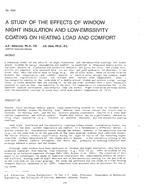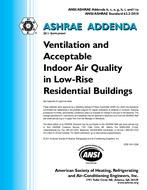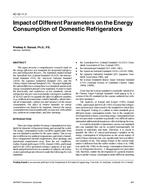Indoor air quality (IAQ) in office environments is important for the well-being of office workers. Poor IAQ can adversely affect human health and reduce occupant cognitive function and productivity. Indoor air includes a complex mixture of gases, such as volatile organic compounds (VOCs), O3, and CO2, along with airborne particulate matter (aerosols). VOCs can be released from exhaled breath, personal care products, building materials, and furnishings. O3 is a highly reactive gas that plays an important role in driving the oxidative capacity of indoor environments. Aerosols can be emitted indoors or delivered from outdoors via the HVAC system. Understanding how people and the operational mode of HVAC systems affect IAQ is essential to determine appropriate ventilation rates for office buildings.
An intensive four-week field measurement campaign was conducted during winter 2019 in an occupied office and its HVAC system to investigate how occupancy and ventilation mode shape the composition and chemistry of indoor air. The office is part of a living laboratory facility, which are four reconfigurable, side-by-side large open-plan office spaces. An integrated building automation system is used for real-time monitoring and precise control of the HVAC system. The fraction of outdoor air varied from 0 to 100% and occupancy was tracked via chair-embedded thermocouples. State-of-the-art analytical and aerosol instrumentation was used to characterize the composition of indoor and outdoor air in real time, including VOCs, O3, CO2, and aerosols from 1 nm to 10 μm. Time-resolved concentrations of VOCs were monitored via proton transfer reaction time-of-flight mass spectrometry (PTR-TOF-MS). A multi-point sampling system was built to sample VOCs, O3, and CO2 at eight locations throughout the air handling unit. Size distributions of aerosols were also sampled upstream and downstream the HVAC filter bank to explore the in-situ efficiency of the filters.
Preliminary results suggest that occupancy and the fractional amount of outdoor air play a significant role in influencing the concentrations of VOCs, O3, CO2, and aerosols. Each species exhibited spatiotemporal variations in concentrations throughout the HVAC system. Human-associated emissions (exhaled breath, personal care products) were found to be the dominant source for numerous VOCs in the office. O3 oxidation of monoterpenes initiated the formation of nano-sized particles, while O3 oxidation of human skin oils produced VOCs such as 6-MHO and 4-OPA. In general, increasing the amount of outdoor air reduced concentrations of indoor-generated VOCs and CO2, while increasing levels of O3 and aerosols.
Citation: 2020 Winter Conference, Orlando, FL Conference Papers
Product Details
- Published:
- 2020
- Number of Pages:
- 10
- Units of Measure:
- Dual
- File Size:
- 1 file , 2.3 MB
- Product Code(s):
- D-OR-20-C059


